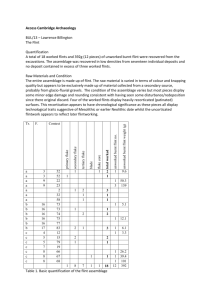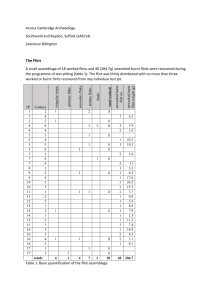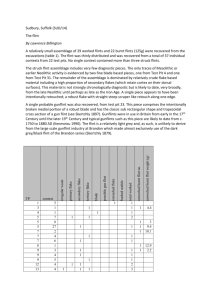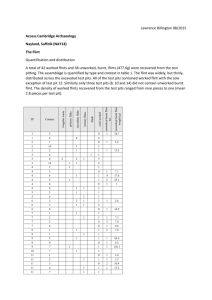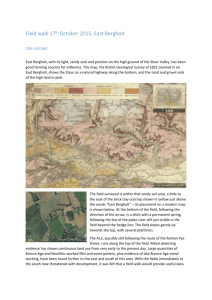Access Cambridge Archaeology
advertisement
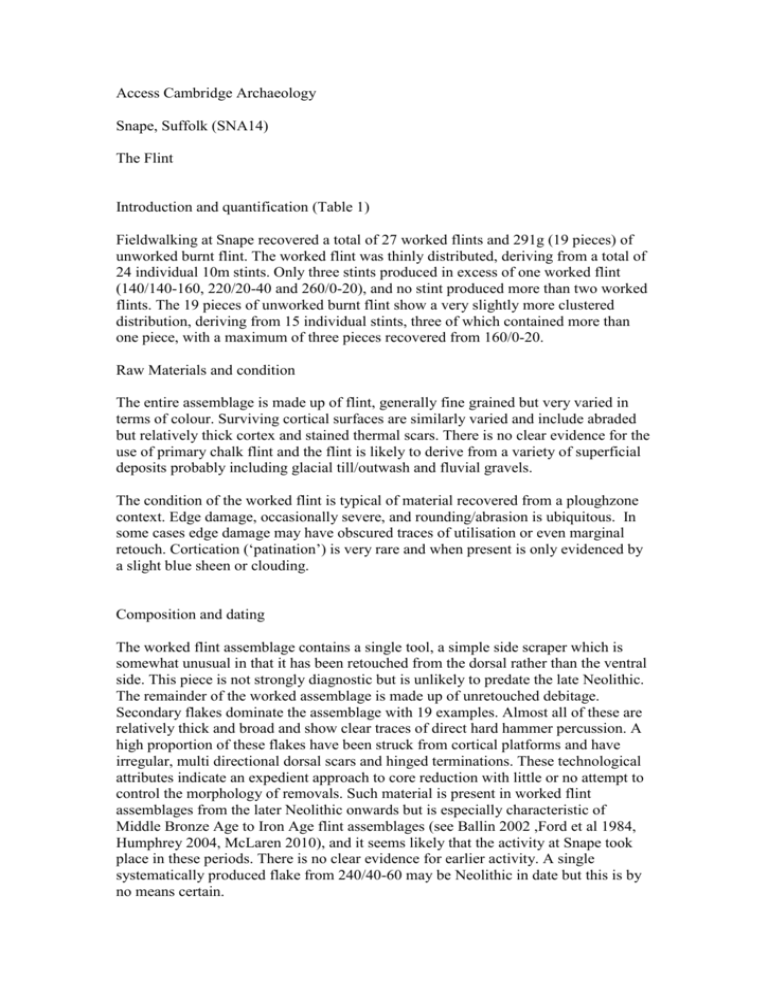
Access Cambridge Archaeology Snape, Suffolk (SNA14) The Flint Introduction and quantification (Table 1) Fieldwalking at Snape recovered a total of 27 worked flints and 291g (19 pieces) of unworked burnt flint. The worked flint was thinly distributed, deriving from a total of 24 individual 10m stints. Only three stints produced in excess of one worked flint (140/140-160, 220/20-40 and 260/0-20), and no stint produced more than two worked flints. The 19 pieces of unworked burnt flint show a very slightly more clustered distribution, deriving from 15 individual stints, three of which contained more than one piece, with a maximum of three pieces recovered from 160/0-20. Raw Materials and condition The entire assemblage is made up of flint, generally fine grained but very varied in terms of colour. Surviving cortical surfaces are similarly varied and include abraded but relatively thick cortex and stained thermal scars. There is no clear evidence for the use of primary chalk flint and the flint is likely to derive from a variety of superficial deposits probably including glacial till/outwash and fluvial gravels. The condition of the worked flint is typical of material recovered from a ploughzone context. Edge damage, occasionally severe, and rounding/abrasion is ubiquitous. In some cases edge damage may have obscured traces of utilisation or even marginal retouch. Cortication (‘patination’) is very rare and when present is only evidenced by a slight blue sheen or clouding. Composition and dating The worked flint assemblage contains a single tool, a simple side scraper which is somewhat unusual in that it has been retouched from the dorsal rather than the ventral side. This piece is not strongly diagnostic but is unlikely to predate the late Neolithic. The remainder of the worked assemblage is made up of unretouched debitage. Secondary flakes dominate the assemblage with 19 examples. Almost all of these are relatively thick and broad and show clear traces of direct hard hammer percussion. A high proportion of these flakes have been struck from cortical platforms and have irregular, multi directional dorsal scars and hinged terminations. These technological attributes indicate an expedient approach to core reduction with little or no attempt to control the morphology of removals. Such material is present in worked flint assemblages from the later Neolithic onwards but is especially characteristic of Middle Bronze Age to Iron Age flint assemblages (see Ballin 2002 ,Ford et al 1984, Humphrey 2004, McLaren 2010), and it seems likely that the activity at Snape took place in these periods. There is no clear evidence for earlier activity. A single systematically produced flake from 240/40-60 may be Neolithic in date but this is by no means certain. unworked burnt flint no. unworked burnt flint weight (g) 1 1 3.3 1 12.3 3 1 24.8 50.1 2 1 34.1 2.6 1 1 11.7 21.6 1 50.1 1 1 16 10.1 1 2.9 1 3.6 1 2 46.3 27 19 291 total worked 1 side scraper flake core tertiary flake secondary flake irregular waste chip Tr S 40 60-80 60 0-20 60 40-60 80 120-140 80 140-160 100 0-20 100 100-120 100 180-200 100 40-60 120 20-40 140 120-140 140 140-160 160 0-20 160 40-60 160 80-100 180 0-20 180 100-120 180 140-160 180 20-40 200 0-20 200 100-120 200 60-80 220 0-20 220 120-140 220 20-40 240 0-20 240 100-120 240 40-60 260 0-20 260 40-60 260 60-80 260 80-100 60/80-100 OR 240/2040 totals 1 1 1 1 1 1 1 1 1 1 1 1 1 1 1 2 2 1 1 1 1 1 1 1 1 1 1 1 1 1 1 2 1 1 1 1 1 1 1 1 2 1 1 1 1 1 1 1 1 1 1 19 4 1 1 Table 1. Quantification of the flint assemblage. The unworked burnt flint is chronologically undiagnostic and small quantities of burnt flint are recovered from sites of all periods. However, routine and relatively large scale burning of flint is generally considered to be a Bronze Age phenomena (e.g. Edmonds et al 1999) and it seems possible that at least some of the burnt flint is contemporary with the activity represented by the worked flint. Ballin, T. B. 2002. Later Bronze Age flint technology: a presentation and discussion of post-barrow debitage from monuments in the Raunds area, Northamptonshire. Lithics23 3-28 Edmonds, M., Evans, C. and Gibson, D. (1999) Assembly and Collection – Lithic Complexes in the Cambridgeshire Fenlands. Proceedings of the Prehistoric Society 65, 47-82 Ford, S., R. Bradley, J. Hawkes and P. Fisher, 1984. Flint-working in the metal age. Oxford Journal of Archaeology 3, 158-73 Humphrey, J. 2004. The use of flint in the British Iron Age: results from some recent research. In Walker, E.A., Wenban-Smith, F. and Healy, F. Lithics in Action Oxford: Oxbow, 243-51 McLaren, A.P., 2010. Household Production in the Middle Bronze Age of Southern and Eastern England: The Mid Term Car Park (MTCP) assemblage, Stansted Airport, Essex, England. Lithics 31, 130-51.
